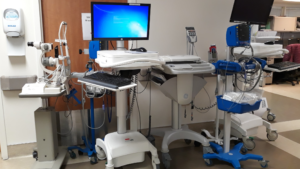Blogs
Nursing BYOD Policies & Compliance
October 25, 2018

A nurse’s shift begins with the nurse checking his or her patient records, preparing for hours of on-the-go work. Over the next eight to twelve hours, lab results are reviewed, e-mails and messages to other healthcare professionals sent, and patient records and education materials referenced and reviewed – all while the nurse is on the move. Luckily the nurse has a mobile device, either personal or hospital-issued, so they can keep in-touch and up-to-date with everything they need. Using a mobile device is so versatile and efficient, a nurse with a hospital-issued WiFi phone changes to his or her personal device in the middle of the day when WiFi coverage stops supporting the WiFi phone’s use. The hospital might prohibit BYOD, but there’s important work to be done and the nurse can’t afford to slow down and find a strong connection or a computer.
Unfortunately, this mobile device usage makes it easier for hackers to go on the attack. It’s more valuable for hackers to target smartphones and for a nurse dealing with sensitive patient information, a single breach on a smartphone or tablet compromises thousands of patients’ data. Patients are left vulnerable and the nurse and hospital now face serious repercussions from a massive HIPAA violation. At the same time as the mobile device breach, a remote access system is hacked. Hackers now have full access to a hospital’s systems, and they quickly install ransomware, steal or encrypt data, or hijack computer resources.
Except, there’s one scenario where none of these attacks were successful.
The nurse reached a hallway with a previous reputation for poor coverage, but Wyebot’s Wireless Intelligence Platform ™ (WIP) provided 24/7 data analytics to enable effective budget and network capacity planning. The hospital knew when upgrades were necessary and WiFi coverage remained strong, meaning the nurse didn’t have to switch to a personal device.
Or, perhaps, WIP was part of a hospital implementation for successful BYOD management and oversight. WIP notified IT which devices were connected to which network, keeping data secure by ensuring personal devices kept to a guest or special BYOD network. Using this information, a device breach or infection remained isolated instead of affecting the entire hospital system. At the same time, client monitoring and device pattern recognition analytics told IT exactly what type and how many devices were on the network. IT always knew exactly what the network was asked to support.
Finally, WIP auto-detected any potential issues in the network and alerted IT with details and actionable steps for resolution before performance degradation. In this way, remote access systems were protected and monitored, preventing any illegitimate access.
Wyebot’s platform uses predictive algorithms and an Artificial Intelligence-based engine to provide complete network visibility, identify potential threats or problems, and keep the network running reliably and efficiently. WIP uses a combination of on-premise sensor hardware and cloud-based, patented software to maintain network stability and optimization. With Wyebot, hospitals are empowered to grow technologically, while ensuring patient safety and well-being are never compromised.



